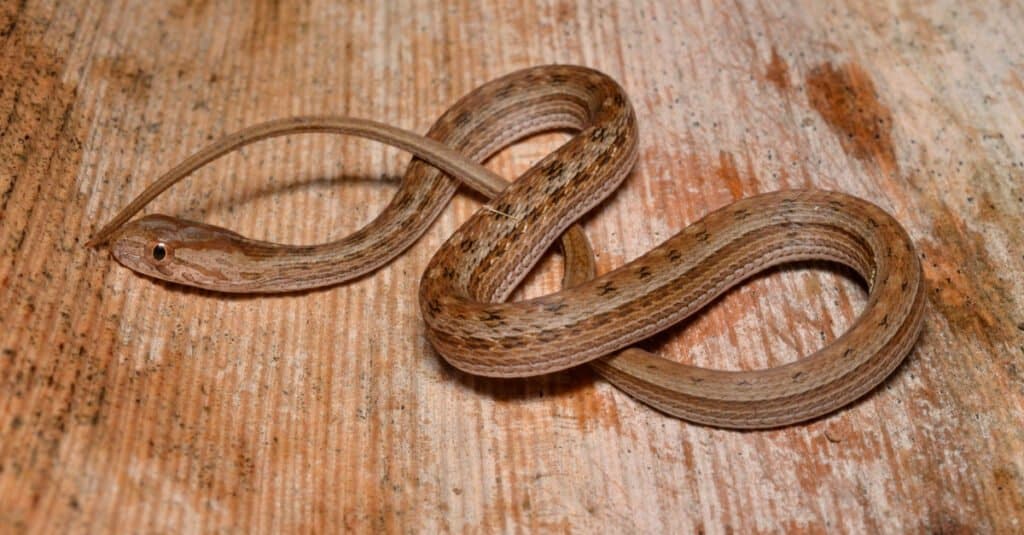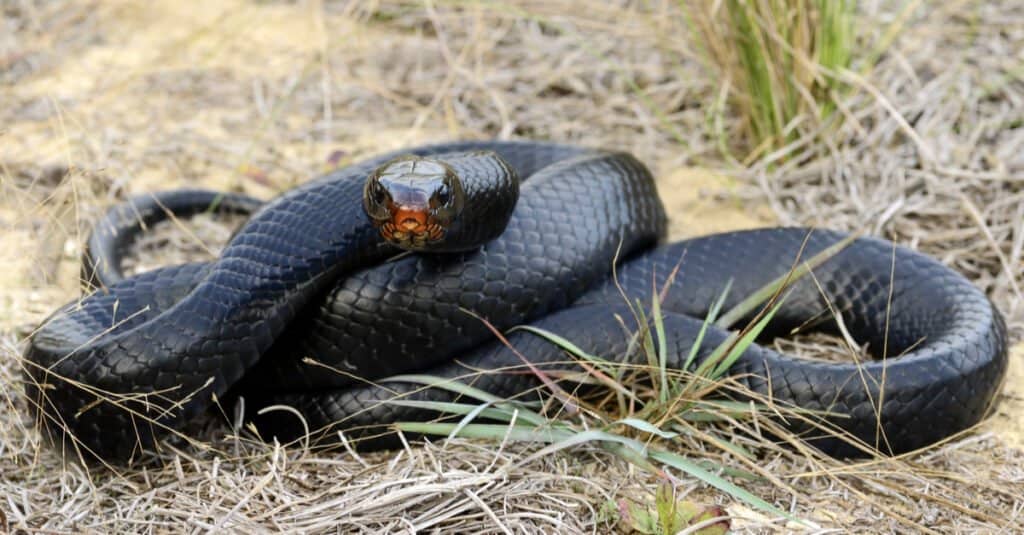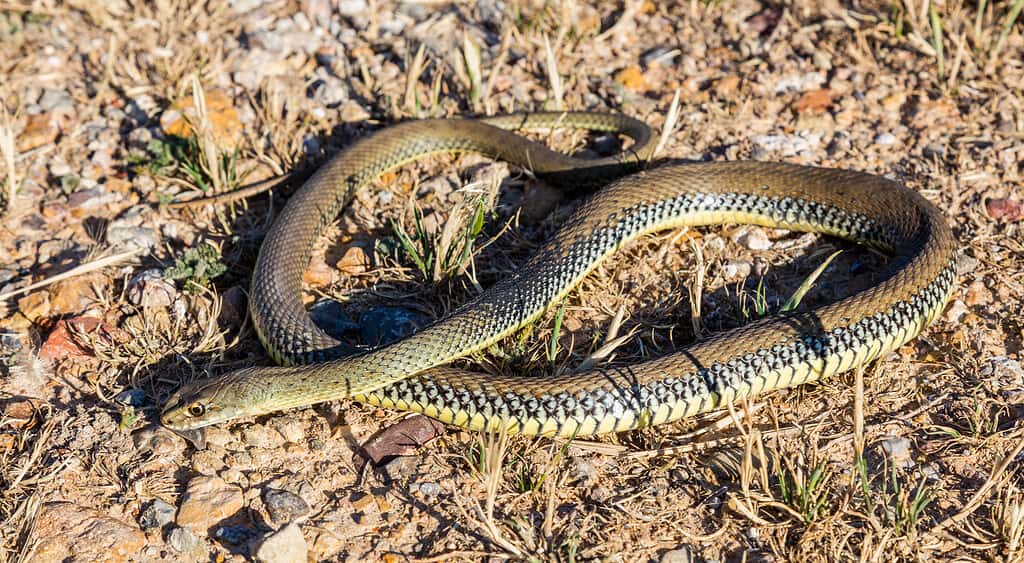Quick Answer:
- Snakes eat themselves due to stress, temperature regulation issues, hypermetabolism, hunger, shedding, constrictive habitat, illness, or confusion.
- Scientists say that a snake may mistake its own tale for that of another snake. Once it begins to feed, it may not even realize that it’s consuming itself.
- This behavior typically happens when a snake is living in captivity.
Does a Snake Really Eat Itself Like the Ouroboros?
At some point, you have probably seen the symbol of the Ouroboros, which is a depiction of a snake eating its tail. This symbol has been around since ancient times, possibly as far back as 5000 BC. In various religions, the symbol has different meanings, such as eternity.
However, the self-devouring snake is not mere symbolism or a myth. As many snake owners have learned and many videos across the internet have shown, sometimes snakes do eat their tails.
This is not believed to be a common occurrence, but it does happen more often than one might think. While it may seem that stories of this happening are becoming more frequent, that is likely only because people now are more likely to have the means of recording the phenomenon.
Also, more people now own snakes as pets, and any rise in the actual occurrences could be due to this fact, as it is hard to keep an artificial habitat exactly the way a natural one would be. This can lead to the snake getting overheated, confused, or stressed out.
So what causes a snake to eat itself? The probable causes are examined in detail right here.
Why Would a Snake Eat Its Own Tail?

©Fabio Maffei/Shutterstock.com
Though the idea of an animal eating itself may seem horrifying, the facts are that snakes aren’t the only animals that do it. Eating oneself is quite common—and disturbing—in birds with injuries. However, the way snakes do it and why they do it is what makes them unique.
What causes a snake to eat itself? No one knows for sure what causes a snake to eat itself, but there are several highly plausible theories. The following are a few reasons that veterinarians suspect can cause this to happen in snakes.
Stress / Temperature
One issue that animal experts think can cause a snake to eat itself as a stress response is their body temperature becoming too high. If you didn’t know, snakes are cold-blooded. This means that they cannot regulate their body temperature. Their body matches the temperature of wherever they are. It is why they sun themselves on rocks in the wild.
Have you or someone you know ever had a problem with biting your nails when you’re stressed out? Snakes don’t have fingernails so they have to find another way to reduce their stress. When exposed to stressors, such as when they get too hot or encounter other animals unexpectedly, sometimes they will bite their tails and even try to swallow them.
This can be harmful and even deadly to the animal, so if it occurs with your pet, it should be dealt with immediately.
Metabolism / False Hunger
Another reason this might be happening is that, when a snake’s metabolism ramps up for some reason, they may mistakenly believe they are ravenously hungry when they are not. If no other food source is available, which it generally isn’t when dealing with a pet snake, they may eat the only thing available: their tail.
This false hunger may also be related to their body temperature kick-starting their metabolism, or it may be due to other factors.
Confusion / Disorientation
A final cause of this behavior may be simple confusion. If a snake becomes disoriented, it may think its tail is prey and try to consume it. Again, the confusion itself may be caused by stress or temperature control issues.
Which Snakes Eat Themselves?

©Patrick K. Campbell/Shutterstock.com
We’ve examined the possible answers to the question, “What causes a snake to eat itself?”, but are there any species more prone to the practice than others?
There does not seem to be any particular species that is more likely to eat itself than any other snake. The fact is any snake kept in an enclosure as a pet may exhibit this behavior when under suboptimal conditions.
Keeping your snake’s enclosure at the appropriate temperature and helping it avoid any kind of stress is the best way to ensure this won’t happen to your pet.
Can I Prevent My Snake From Ever Eating Its Own Tail?
To try to avoid this behavior, the best thing to do is learn everything you can about the care and feeding of the breed of snake you have or want to have. The most important facts to consider are: What is the snake’s optimal habitat temperature?
Most snakes live in a variety of different habitats including forests, grasslands, deserts, and swamps. Some are more active at night and others during the day. Snakes are predators and eat many different types of small animals, eggs, and insects.
It’s important to make sure you’ve done your research on what your snake needs before bringing it home.
Some questions to ask yourself:
How large does the snake’s enclosure need to be? What does my snake eat? How often does my snake need to eat? How much does my snake need to eat? Does the snake tolerate having other pets around?
What Should I Do if I Find My Snake Eating Itself?
It can be very frightening to see your pet snake biting its tail. Though it may not be, this can be a very serious and even life-threatening event if it continues for long enough that the tail reaches the digestive juices.
If you find your snake this way and more than the very tip of its tail is inside its mouth, it should be considered an urgent situation.
If you are there when it first starts biting its tail, you should first make sure the animal’s teeth are not embedded in its skin, then try to gently extract the tail from its mouth. With many snakes, this can be done by simply pulling its head away from its tail.
However, with some breeds that may have hinged jaws, this method alone will not work. In this case, you will have to tap it on the nose, possibly several times, to get it to let go before you can pull the tail out of its mouth.
If you are unable to successfully remove the tail from the snake’s mouth, get the pet to an emergency vet immediately. If possible, find a follow-up veterinarian that specializes in snakes, but getting the pet to a medical setting is the top priority regardless.
The vet should be able to assist with extracting the tail from the snake’s throat, assuming it has not gotten too far along. The vet should also be able to tell you what steps to take to keep the behavior from happening in the future.
If you are successful in extracting the tail from its mouth on your own, it is important to take other steps immediately to stop the tail-eating behavior from recurring. To begin with, you will need to cool the snake down right away. You can take it to a cooler area, turn off its heat lamps, and also spritz it with cool water to help reduce its body temperature.
Regulating the snake’s body temperature and keeping it cooler is the number one step to take to try and stop this behavior from ever occurring again. This may mean you need to reassess its enclosure to determine how to keep it from overheating in the future.
If its temperature seems fine, are there other factors that might be causing the snake stress, such as other visible pets? If so, some sort of divider should be used so the snake cannot see the other pet. Could something else be causing it to become disoriented?
If possible, make an appointment with a vet to have the snake checked out and discuss a plan of action to manage their temperature and their stress levels.
Why Do Snakes Eat Other Snakes?

It may seem rather unusual for a snake to eat itself, and you may think it equally as strange that they eat each other but there is perhaps, a legitimate reason for this. A theory on why this behavior occurs is that since snakes generally use the same resources and typically feed on the same prey, by eating them, it is taking out the competition. Not only for these resources but for the possibility of securing a mate, and cannibalism quite often occurs after two males engage in a fight.
What is rather unusual is when the males resort to eating the females, as is the case with the Montpellier snake (Malpolon monspessulanus). This serpent is commonly found in Portugal, Spain, and Northwest Africa, as well as the southern Mediterranean coast of France, and has been documented eating females outside of the mating season. However, it is believed they do this for the same reason as other cannibalistic snakes – taking out the competition for food sources.
Then there are other species, like the King Cobra (Ophiophagus hannah) and Cape cobras (Naja nivea), that will actively hunt other species. Although, it once was occurring only during times of hardship but is now understood to be a regular occurrence. Many of these species, like the cobras mentioned, are opportunistic predators and incorporate them into their regular diet.
The photo featured at the top of this post is © Kurit afshen/Shutterstock.com
Discover the "Monster" Snake 5X Bigger than an Anaconda
Every day A-Z Animals sends out some of the most incredible facts in the world from our free newsletter. Want to discover the 10 most beautiful snakes in the world, a "snake island" where you're never more than 3 feet from danger, or a "monster" snake 5X larger than an anaconda? Then sign up right now and you'll start receiving our daily newsletter absolutely free.
Thank you for reading! Have some feedback for us? Contact the AZ Animals editorial team.







